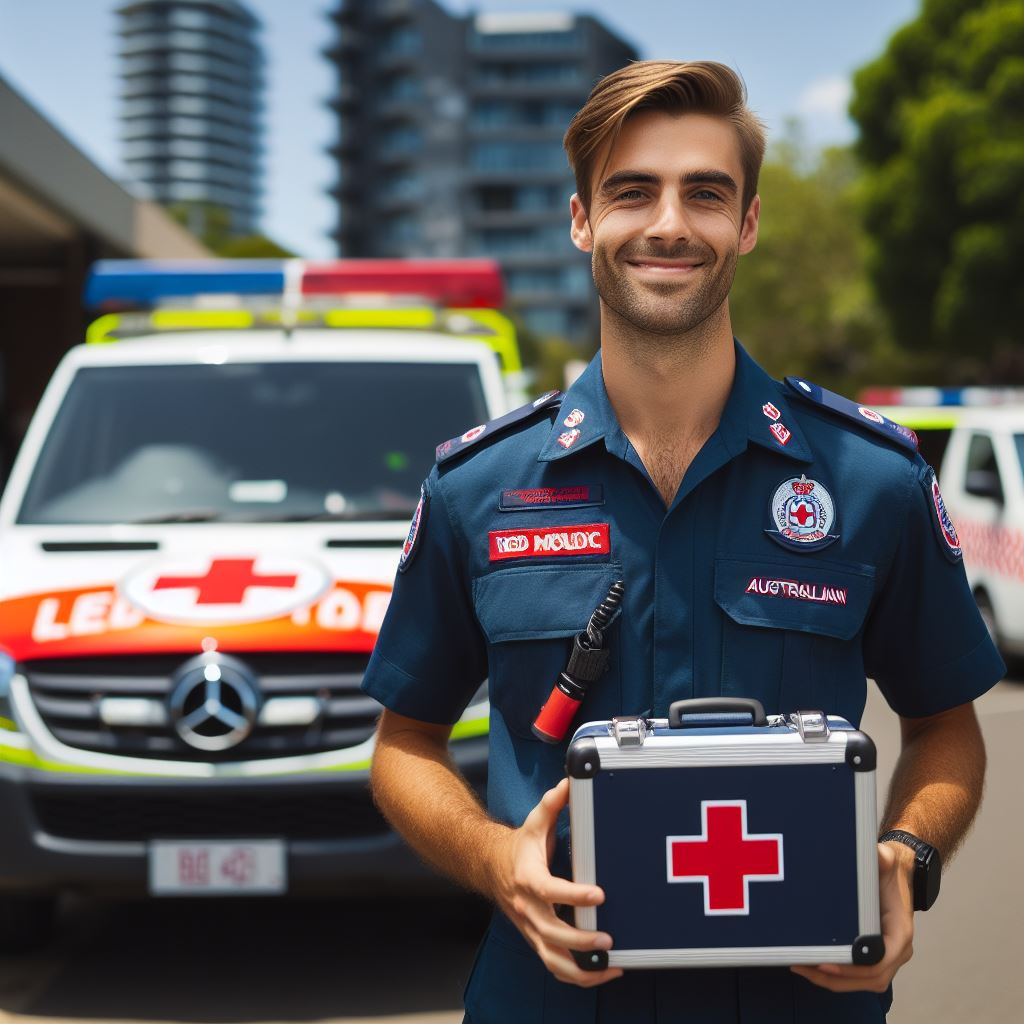Introduction
A. Brief Explanation of the Topic
Paramedics, the unsung heroes of emergency response, vary globally.
From protocols to training, each country shapes its paramedic system uniquely.
B. Importance of Comparing Paramedics in Different Countries
Understanding global paramedic practices is crucial for fostering collaboration, improving standards, and enhancing emergency medical services worldwide.
C. Thesis Statement
This blog post aims to compare paramedics in Australia and abroad, shedding light on their nuanced practices, shared challenges, and distinctive approaches.
Explore the diverse world of paramedicine with us.
1. Training Programs
- Australia: Rigorous academic and practical training.
- Abroad: Varied, with differences in duration and intensity.
2. Scope of Practice
- Australia: Broad range, often including minor surgical procedures.
- Abroad: Varies, influenced by local regulations and medical infrastructure.
3. Equipment and Technology
- Australia: High-tech ambulances, advanced life support equipment.
- Abroad: Disparities exist, with some regions lacking cutting-edge resources.
Join us in this comparative exploration, delving into the heartbeat of emergency medical services worldwide.
Overview of Paramedics in Australia
A. Job description and responsibilities
In Australia, paramedics are highly skilled healthcare professionals who respond to emergency situations to provide medical care.
They are responsible for assessing patients, administering life-saving treatments, and transporting them to medical facilities.
B. Requirements and qualifications
To become a paramedic in Australia, individuals must meet certain requirements and possess specific qualifications.
This includes completing a bachelor’s degree in paramedicine, as well as obtaining certification in advanced life support.
C. Training and education
Paramedic training in Australia involves a combination of academic study and practical experience.
Students learn about anatomy, physiology, pharmacology, and gain skills in emergency procedures and patient care.
D. Regulatory bodies and professional associations
The paramedic profession in Australia is regulated by various bodies, such as the Australian Health Practitioner Regulation Agency.
Professional associations, like Paramedics Australasia, provide support, resources, and promote professional development for paramedics.
E. The challenges faced by paramedics in Australia
Paramedics in Australia face unique challenges due to the vast size of the country and diverse geographical locations.
Your Personalized Career Strategy
Unlock your potential with tailored career consulting. Get clear, actionable steps designed for your success. Start now!
Get StartedThey often need to travel long distances to reach patients, face extreme weather conditions, and encounter high-stress situations.
Additionally, paramedics may also face occupational hazards, including exposure to infectious diseases and physical injuries.
Read: Internship Insights: Becoming an Aussie Paramedic
Overview of Paramedics Abroad
A. Comparison of job description and responsibilities to Australia
- Paramedics abroad have similar core duties but may vary in scope and specific protocols.
- They provide emergency medical care, assess patients, and transport them to appropriate healthcare facilities.
- Collaboration with other healthcare professionals and effective communication skills are crucial in their role.
B. Requirements and qualifications in various countries
- Each country may have specific requirements for becoming a paramedic, including education, certification, and licensure.
- While some countries offer a single paramedic certification, others require advanced levels of education and training.
- Language proficiency and cultural awareness may also be necessary for paramedics working abroad.
C. Variances in training and education programs
- Training programs for paramedics abroad can range from diploma programs to bachelor’s degrees.
- Some countries prioritize hands-on clinical experience, while others focus more on theoretical knowledge.
- Paramedics may undergo specialized training in areas such as trauma, pediatrics, or cardiac care.
D. Regulatory bodies and professional associations in selected countries
- Each country typically has its own regulatory body responsible for setting standards and regulations for paramedics.
- Professional associations play a vital role in advocating for paramedics and providing continuing education opportunities.
- Examples of regulatory bodies include the National Registry of Emergency Medical Technicians in the United States and the Health and Care Professions Council in the United Kingdom.
E. The challenges faced by paramedics abroad
- Paramedics working abroad may encounter language barriers, cultural differences, and unfamiliar healthcare systems.
- Adjusting to new protocols, equipment, and procedures can be challenging and require adaptability.
- Dealing with high-stress situations and witnessing traumatic events can take a toll on paramedics’ mental and emotional well-being.
- Support systems, including peer support groups and access to counseling services, are crucial in addressing these challenges.
Generally, paramedics abroad have similar core job responsibilities to those in Australia, but there are notable differences in requirements, qualifications, training programs, and regulatory bodies.
The challenges faced by paramedics working abroad highlight the importance of ongoing support and adaptation to new environments.
Understanding these variations can foster international collaboration and knowledge exchange in the field of paramedicine.
Read: Continual Learning for Australian Paramedics
Comparison of Australian paramedics and those abroad
A. Salary and benefits comparison
- Australian paramedics are generally well-compensated, with competitive salaries and comprehensive benefits packages.
- Paramedics abroad may have variable salaries and benefits depending on the country they work in.
- In some countries, paramedics receive higher salaries and better benefits than their Australian counterparts.
- However, there are also countries where paramedics earn significantly lower salaries and have limited benefits.
B. Work environment and conditions comparison
- Australian paramedics work in a diverse range of environments, including urban areas, rural regions, and remote areas.
- Paramedics abroad may work in similar environments, but there can be significant differences in the resources and infrastructure available.
- Some countries may have better-equipped ambulances and medical facilities, while others may have limited resources.
- Australian paramedics often face unique challenges, such as extreme weather conditions and long distances to reach patients.
- Paramedics abroad may encounter different challenges, such as language barriers and cultural differences.
C. Scope of practice differences
- Australia has a well-defined scope of practice for paramedics, allowing them to provide advanced life support and administer certain medications.
- In some countries, paramedics have similar scopes of practice to Australian paramedics, but there can be variations in the types of procedures they are allowed to perform.
- Other countries may have more restrictive scopes of practice, limiting paramedics to basic life support interventions.
- Some countries may allow paramedics to perform invasive procedures that are not within the scope of practice for Australian paramedics.
D. Equipment and resources availability comparison
- Australian paramedics have access to modern equipment and advanced medical technologies.
- In some countries, paramedics may have comparable access to state-of-the-art equipment and resources.
- However, there are also countries where paramedics face resource limitations, including outdated equipment and inadequate supplies.
- Availability of specialized equipment, such as ventilators or defibrillators, may vary between countries.
E. Cultural and social differences affecting paramedic practice
- Cultural and social factors can greatly influence the practice of paramedics in Australia and abroad.
- In multicultural societies like Australia, paramedics often encounter patients from diverse cultural backgrounds, requiring cultural sensitivity and effective communication.
- Paramedics abroad may face similar challenges, but in a different cultural context, which may require additional cultural understanding and adaptation.
- In some countries, cultural or social norms may impact the acceptance of paramedic care and the willingness of patients to seek medical assistance.
- Understanding and respecting cultural and social differences is crucial for providing quality care as a paramedic, regardless of the location.
In a nutshell, Australian paramedics share similarities with global counterparts but differ significantly in salary, work environment, scope of practice, equipment/resources availability, and cultural factors.
Recognizing and understanding these differences is essential for fostering effective collaboration and learning across borders in the field of paramedic practice.
Read: Paramedics and Public Health in Australia

Case Studies of Paramedics in Australia and Abroad
A. Successful Australian paramedic and their achievements
Meet Sarah, an outstanding paramedic from Australia, who has made significant contributions to the field.
Sarah’s dedication and expertise have earned her numerous awards and accolades in the country.
She has handled complex emergency situations with utmost professionalism, saving many lives in the process.
Sarah’s commitment to continuous learning and professional development sets her apart from her peers.
She actively participates in research projects and shares her knowledge through conferences and publications.
With exceptional communication skills, Sarah effectively interacts with patients, their families, and other healthcare professionals.
Her ability to remain calm under pressure and make critical decisions ensures optimal patient car
B. Case study of a paramedic working abroad and their experiences
Now, let’s explore the journey of Mark, a highly skilled paramedic who works in a foreign country.
Mark, originally from Australia, decided to pursue his passion for emergency medical services overseas.
He faced unique challenges, such as adapting to a different healthcare system and cultural differences.
Working in a diverse environment enriched Mark’s knowledge and expanded his skill set.
He learned alternative techniques and approaches from local paramedics, enhancing his overall proficiency.
Mark’s ability to thrive in unfamiliar settings and collaborate with a diverse team earned him respect and recognition.
His experiences abroad have broadened his perspective and made him a more resourceful and adaptable paramedic.
C. Lessons learned from different experiences and contexts
Comparing Sarah’s accomplishments in Australia with Mark’s experiences abroad reveals valuable insights.
Both paramedics demonstrate exceptional skills and dedication, but in different contexts.
Sarah’s achievements highlight the strength of Australian paramedic training and support systems.
Stand Out with a Resume That Gets Results
Your career is worth more than a generic template. Let us craft a resume and cover letter that showcase your unique strengths and help you secure that dream job.
Get HiredOn the other hand, Mark’s exposure to different healthcare systems underscores the importance of adaptability.
Lessons can be learned from both paramedics, emphasizing the significance of continuous learning and professionalism.
The exchange of knowledge and experiences between paramedics in different countries can lead to innovation and growth.
By embracing diversity and incorporating best practices from various contexts, the global paramedic community can excel further.
In essence, the case studies of paramedics in Australia and abroad demonstrate the exceptional skills, achievements, and lessons learned in diverse contexts.
Sarah’s success in Australia showcases the effectiveness of local training and support, while Mark’s experiences abroad highlight the value of adaptability and embracing diversity.
By sharing knowledge and experiences, paramedics worldwide can enhance patient care and drive innovation in emergency medical services.
Read: How Aussie Paramedics Cope with Stress
Find Out More: How to Become a Surgeon in Australia: A Guide
Emerging Trends and Future Prospects for Paramedics in Australia and Abroad
A. Introduction of new technologies and their impact on the profession
Paramedics across the globe are witnessing significant changes in their profession due to the introduction of new technologies.
New equipment and innovative solutions are revolutionizing the way paramedics deliver care to patients.
These advancements have become vital in improving patient outcomes and enhancing the overall efficiency of emergency medical services.
For instance, the integration of mobile technology has allowed paramedics to access real-time patient data, communicate with healthcare professionals, and make informed decisions promptly.
This immediate access to critical information significantly improves the quality and speed of patient care.
In addition, the utilization of state-of-the-art monitoring devices helps paramedics gather accurate data, monitor vital signs, and assess the severity of a patient’s condition.
These devices, including advanced ECG machines and portable ultrasound systems, enable paramedics to quickly diagnose and provide appropriate treatment.
Moreover, the adoption of telemedicine and telehealth platforms has enabled paramedics to collaborate with remote healthcare professionals.
Through video consultations, medical experts can provide guidance to paramedics in challenging situations, enhancing the level of care delivered to patients in remote or underserved areas.
B. Identification of potential advancements and developments
The future of paramedicine holds great potential for further advancements and developments.
As technology continues to evolve, paramedics can expect to see improvements in their equipment and protocols.
Some potential advancements include:
- Wearable Devices: Paramedics may utilize wearable technology to monitor patients remotely, collect data, and provide continuous care even after their initial assessment.
- Artificial Intelligence (AI): AI-powered systems can analyze patient data, identify trends, and assist paramedics in making accurate diagnoses and treatment decisions.
- Drones and Robotic Assistance: Unmanned aerial vehicles (UAVs) can rapidly transport emergency medical supplies and equipment to inaccessible areas, ensuring prompt medical assistance.
- Virtual Reality (VR) Training: Paramedics can benefit from immersive VR simulations to enhance their skills, practice critical scenarios, and improve decision-making abilities.
C. Potential career opportunities in the field
The integration of new technologies and emerging trends in paramedicine presents exciting career opportunities for professionals in the field.
Paramedics who embrace these advancements and adapt to changing practices will be in high demand globally.
Telemedicine and remote healthcare specializations can broaden paramedics’ opportunities in diverse environments—rural areas, disaster zones, and international medical missions.
Paramedics with a tech background can explore roles as medical device trainers, clinical consultants, or researchers, contributing to innovative solutions in emergency care development.
The demand for paramedics is also expected to rise due to demographic changes such as an aging population, increased urbanization, and the occurrence of natural disasters.
These factors will require a larger workforce to meet the growing needs of emergency medical services.
Transform Your LinkedIn for Maximum Impact
Elevate your professional brand with a LinkedIn profile that attracts recruiters, showcases your expertise, and maximizes opportunities. Stand out in your industry with a profile built for success.
Boost ProfileBasically, the introduction of new technologies in paramedicine is transforming the profession and opening up promising career prospects.
Embracing trends and advancements, paramedics can enhance care, improve patient outcomes, and contribute to advancing emergency medical services globally, including in Australia.
Conclusion
In this section, we have explored the similarities and differences between paramedics in Australia and abroad.
We discussed the training and education requirements, the scope of practice, and the level of autonomy for paramedics in both contexts.
Comparing paramedics in Australia and abroad is crucial for several reasons.
It allows us to gain a broader perspective on the profession, identify best practices, and learn from different healthcare systems.
This comparison can ultimately lead to the improvement of paramedic services globally.
Paramedics play a vital role in providing timely and critical care to patients in pre-hospital settings.
It is essential to continually evaluate and study the profession to ensure the highest standards of care.
By comparing paramedics in Australia and abroad, we can enhance their skills, training, and overall effectiveness in delivering life-saving interventions.
Let us continue to foster international collaboration and exchange of knowledge to advance the field of pre-hospital care.




